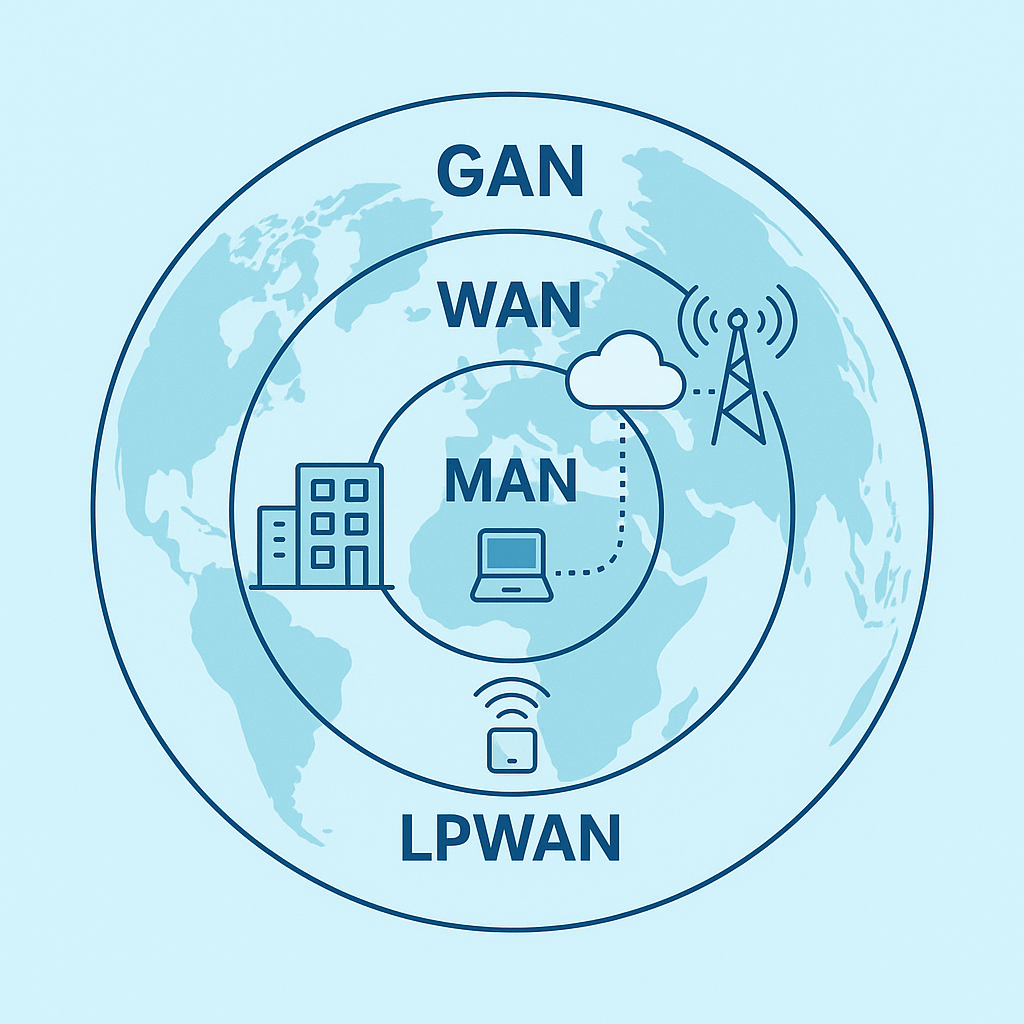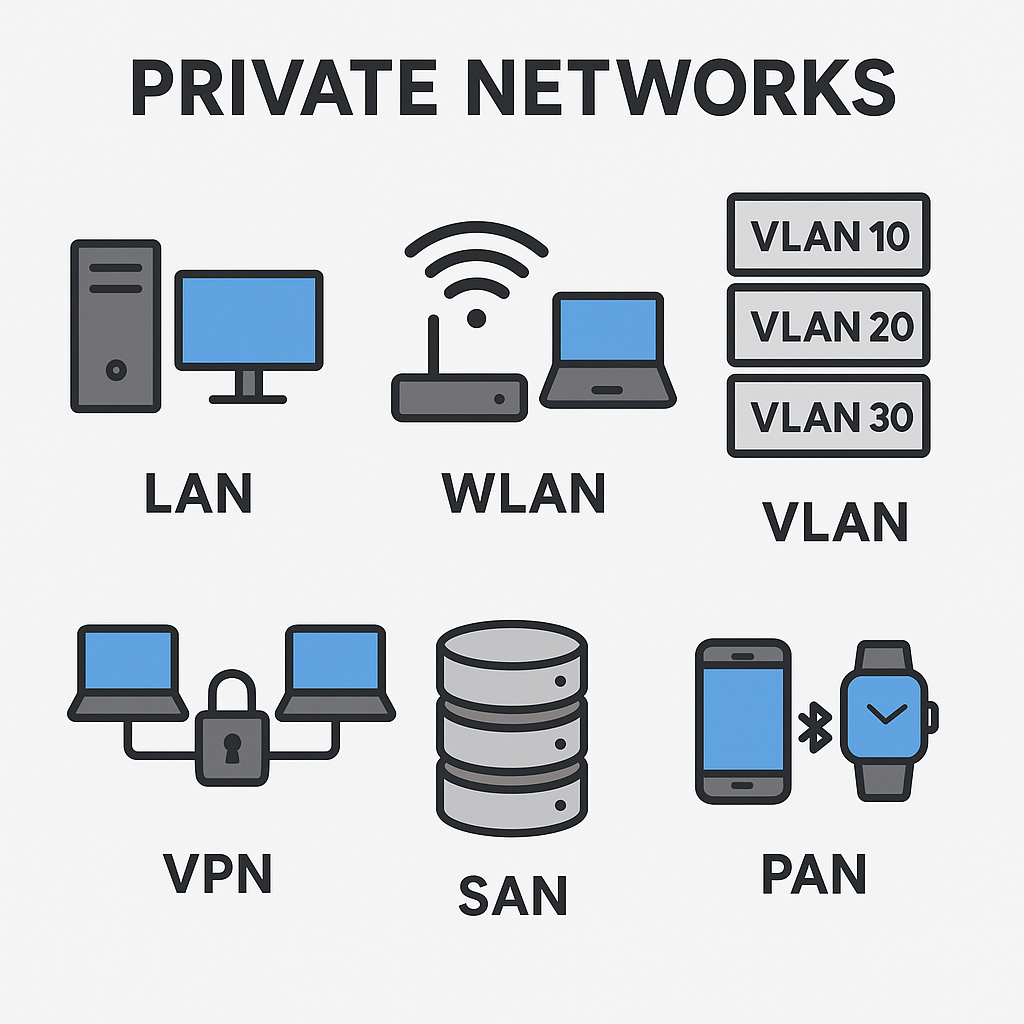Sharing notes from my ongoing learning journey — what I build, break and understand along the way.
Public and Private Networks: From Basics to Advanced
Understanding Public and Private Networks in Depth
One of the invisible yet most critical parts of our daily lives are networks. Whether we connect to the internet, talk on the phone, send a file to an office printer, or watch our smartwatch sync with our phone via Bluetooth, we are always inside a network. Moreover, not all of these networks are the same; some belong to us (private networks), while others are large infrastructures operated by telecom operators and service providers (public networks).
Understanding this distinction is important because the type of network determines our level of control, security approach, and technical solutions. At home, changing the Wi-Fi password is in our hands, but there is nothing we can do when there is an outage in the internet backbone. In this article, I will examine each type of network and explain both conceptual and technical aspects. With simple examples we will establish the basic logic, and then move on to the details used at the professional level.
Public Networks
Public networks are not operated by individuals or companies but by telecom operators, service providers, or governments, serving large populations. Their scope is broad, and the number of users is in the millions. Here, we are not talking about “my house or my office” but “connections across cities, countries, and continents.”

WAN – Wide Area Network
WAN is the most commonly heard and used public network. As the name suggests, a wide area network covers large geographical distances. The ADSL, VDSL, fiber, cable internet, and 4G/5G mobile networks we use to connect to the internet are all parts of WAN.
From a technical point of view, WAN connects different local networks (LANs). For your home computer to reach Google’s data center, a huge chain is at work — starting from your modem connected to the ISP infrastructure, all the way to undersea fiber cables. That whole chain is WAN.
Without WAN, the global internet would not be possible. But WAN has one property: you don’t control it. You cannot fix an outage, arbitrarily increase or decrease your speed, or eliminate latency. Authority belongs to the provider. What professionals do at this point is accept WAN’s limitations and build solutions on top of it, such as VPN, SD-WAN, and QoS.
LPWAN – Low Power Wide Area Network
LPWAN is a type of network that has entered our lives in recent years, especially with the concept of the Internet of Things (IoT). Its main purpose is to connect devices that consume very little energy to the internet over kilometers of distance.
Think about it: every parking sensor in a city or every soil moisture sensor in a field doesn’t have constant access to electricity. They need to work for years on a battery. That is why LPWAN technologies (LoRaWAN, Sigfox, NB-IoT) exist. Their data rates are low (a few kilobits per second), but their energy consumption is so low that they can operate for years on a small battery.
You can think of LPWAN as a type of WAN built more on efficiency and coverage than speed.
MAN – Metropolitan Area Network
MAN literally means “metropolitan network.” It refers to networks that cover a city. For example, a municipality connecting all of its buildings with its own fiber network, or an internet service provider offering metro-ethernet infrastructure throughout a city, are typical examples of MAN.
Technically, MAN is larger than a LAN but smaller than a WAN. It usually uses high-speed fiber ring topologies. The goal is to connect institutions or users within the same city with low latency. In professional settings, MAN connections are preferred for replication between data centers or high-speed links between city offices.
GAN – Global Area Network
GAN is the largest-scale network. In a sense, it is “the internet itself.” What makes the internet possible is actually hundreds of different WANs coming together to form a massive GAN.
Submarine fiber cables, intercontinental satellite links, the global telephone network (PSTN), and the backbones of international operators — all of these are parts of GAN.
The most important feature of GAN is that it provides global access. In other words, you can send data from anywhere in the world to anywhere else. But at the same time, it is also the layer where you have the least control. That’s why professionals try to improve service quality on GAN using additional solutions such as Content Delivery Networks (CDN), Anycast DNS, and DDoS protection.
Private Networks
Private networks are owned and fully managed by individuals or organizations. Your home Wi-Fi, your office LAN cabling, or even the Bluetooth connection between your phone and your headset all fall into this group. Here, you are in control: you set the rules, manage, and segment.

LAN – Local Area Network
LAN is the most fundamental type of private network. The entire wired network inside a house, an office, or a school campus is a LAN. The biggest advantage of LAN is that it is fast, reliable, and low-latency. In modern LANs, 1 Gbps has become standard, and 10 Gbps connections are increasingly common.
For professional network engineers, LAN is the backbone of all design. Segmentation (VLAN), access control (ACL), security (802.1X), and power distribution (PoE) all take place on LAN.
WLAN – Wireless LAN
WLAN is the wireless version of LAN. In other words, Wi-Fi. The wireless network your phone connects to at home is actually an extension of LAN; the only difference is that the data is transmitted over the air.
The greatest advantage of WLAN is mobility and flexibility, while its disadvantage is the risk of security and interference. In professional environments, WLAN deployment is a serious engineering task involving channel planning, access point placement, and encryption protocols (WPA3).
VLAN – Virtual LAN
VLAN is the method of creating multiple virtual networks on a single physical network. Simply put, you may have a single cabling and switch infrastructure in a building, but thanks to VLAN you can separate users, servers, IoT devices, and guests into different networks.
Without VLANs, security and manageability would be impossible in large networks. Professionals often use VLANs together with inter-VLAN routing, ACLs, and Voice VLANs.
VPN – Virtual Private Network
A VPN is a method of establishing a secure and encrypted connection over an untrusted network (usually the internet). Connecting remote offices (site-to-site VPN) or an employee connecting to the corporate network from home (remote access VPN) are examples.
The importance of VPN comes from this: data passing over WAN and GAN can be public to everyone. With VPN, you encrypt this traffic and ensure confidentiality and integrity.
For professionals, VPN means not only an encrypted tunnel but also authentication, access policies, and performance optimization.
SAN – Storage Area Network
SAN is a private network used for storing data. The purpose here is to provide block-level storage (which appears like a disk) to computers. Its difference from NAS is that SAN does not share files, but instead provides block-level access.
In large companies, virtualization clusters (VMware, Hyper-V) or databases usually run on SAN. This is because SAN provides very low latency and high IOPS. Fibre Channel and iSCSI are the most well-known SAN technologies.
PAN – Personal Area Network
PAN is a very short-range network established between our personal devices. Our Bluetooth headset, smartwatch, or NFC payment with our phone — all of these are examples of PAN.
PAN may look small, but in fact, it is the most personal of private networks. From a security perspective, even a poorly configured Bluetooth device can become an entry point for an attacker.
In Short
Dividing networks into private and public makes it easier to understand the big picture for both everyday users and professionals. Public networks provide us with infrastructure and access; private networks give us control and flexibility. Without WAN, we couldn’t connect to the internet; without VLAN, we couldn’t manage a large network; without VPN, we couldn’t ensure secure remote access.
Each concept has its own technical details, but they are all parts of a whole. When we understand this whole, whether we are home users or administrators of a large corporate network, we can produce more conscious and secure solutions.
